Summary
Key questions
- Why are Climate Policies both promoting and contradicting the Energy Efficiency First Principle?
- Why is it not enough to reduce carbon emissions? Why do we also need to save energy?
- How to integrate the Energy Efficiency First Principle into overall decarbonization?
Lead authors: Barbara Schlomann and Wolfgang Eichhammer (Fraunhofer ISI)
Reviewers: Fouad Al-Mansour and Matjaž Česen (Jozef Stefan Institute)
Policies to combat climate change rely on transformational aspects which both promote and contradict the Energy Efficiency First (EE1) Principle: On the one hand, the penetration of energy efficient industrial processes, efficient buildings and appliances, as well electric cars clearly rely on the EE1 Principle. On the other hand, the decarbonisation of industrial processes, of transport fuels for aircraft, shipping or heavy trucks based on hydrogen and Power-to-X (PtX), the penetration of IT solutions to support flexibility in sector-coupling, and the development of energy communities may lead to a strong increase in energy demand. The policy brief explores these contradictions and solutions to overcome the contradictions.
Setting the scene: The contribution of energy efficiency to reducing energy consumption and CO2 emissions and the Energy Efficiency First (EE1) Principle
The decomposition of final energy consumption based on the ODYSSEE database clearly shows the central role of energy efficiency in the decline in final energy consumption observed in the past.
Figure 1: The contribution of energy savings and energy efficiency to final energy consumption in the EU in past decades

Source: ODYSSEE Database, Decomposition Tool
The revised Energy Efficiency Directive (EED 2023) entered into force on 10 October 2023. Article 3 of the revised Directive establishes “Energy Efficiency First (EE1)” as a fundamental principle of EU energy policy (Figure 2).
Figure 2: Article 3 of the Energy Efficiency Directive EED enshrining the Energy Efficiency First Principle

Source: Europea Energy Efficiency Directive EED (2023)
Energy efficiency must be considered by EU Member States in all relevant policy and major investment decisions taken in the energy and non-energy sectors. Cost-benefit analyses are needed taking wider benefits of energy efficiency solutions (the so-called co-benefits or multiple benefits) into account beyond pure energy and energy cost savings.
How climate policies both promote and contradict the EE1 Principle
There are a numerous climate policies which strive to decarbonize energy carriers. While this may ultimately lead to climate neutrality in all cases, these strategies are not all equivalent when an energy efficiency view is taken. This is illustrated in Figure 3 with different ways to decarbonize passenger transport: battery electric vehicles, fuel cell vehicles, and internal combustion engines based on synthetic fuels derived from hydrogen. All three pathways lead to decarbonized passenger transport, but the chain efficiency of the battery-electric vehicles is more than two times higher than that of fuel cells and more than five times higher than that of synthetic fuels in internal combustion engines.
Figure 3: Examples why certain climate policies contract the EE1 principle: The conversion of energy carriers is associated with losses
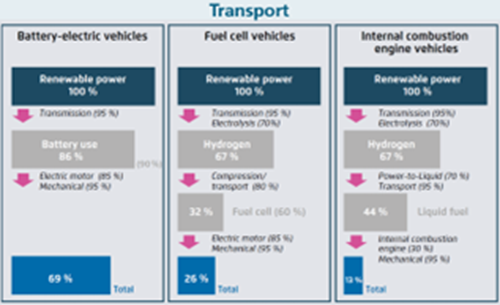
Source: Agora/Frontier Economics (2018)
The picture, however, is incomplete, without taking into account a broader view on the Multiple Impacts (MI) of climate neutrality pathways, as requested by the EE1 principle. Figure 4 exemplifies such impacts, while generating electricity either with fossil fuels (upper picture: open pit coal mines; lower picture: Direct Air Capture DAC to remove the carbon emissions) or renewables (upper picture: wind converters and transmission lines)
Figure 4: : Examples of environmental impact of energy supply (fossil fuels: land-use, air pollution, material uses) and renewables (land-uses, impacts on landscapes, material uses)
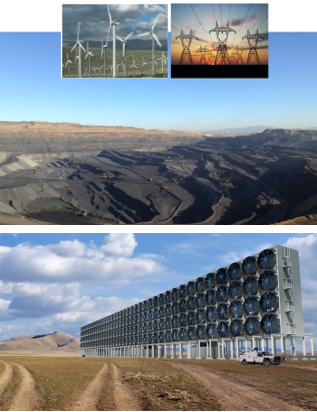
Source: http://www.sciencemag.org/news/2018/06/cost-plunges-capturing-carbon-dioxide-air
In the example discussed in Figure 3 for passenger transport, mining activities for the provision of lithium are linked to important environmental impacts, as are the other two pathways to climate neutrality mentioned, which have to be taken in consideration while implementing the EE1 principle.
Additionally, we must consider whether our present lifestyles are encountering the technical successes which have been achieved (or will be achieved during the transformation processes). This is illustrated with Figure 5 regarding direct electrification of transport. In Figure 3, we have discussed the chain efficiency gains associated with direct electrification, while considering the impacts related to lithium mining. Figure 5 shows, in the lower three columns, that when moving to fuel cells or synthetic fuels, we will have to add the important conversion losses (CL) of hydrogen and synthetic fuel production to the final energy consumption of transport (today about 4396 TWh) to reach 4860 (fuel cells) or even 9940 TWh (synthetic fuels). But even when moving to electric vehicles, large differences are observed, depending on how far Sports Utility Vehicles (SUVs) are penetrating the market with their larger weight and less aerodynamic profile (car drag area). This could reach from an overall consumption of 1388 TWh for the transport sector in the case of full electrification and without the SUV trend (i.e. car weight and drag area from 1980) to 2268 TWh (with 100% SUVs, compared to 50% today), i.e. nearly a doubling of the final energy demand, even if the final consumption is still considerably lower than the presented final energy demand based on gasoline and diesel (see red column with 4396 TWh). This shows the important impact of sufficiency strategies, which would also manifest in the additional impacts mentioned above such as less mining for batteries, less area used for renewables, fewer impacts on biodiversity etc.
Figure 5: Direct electrification of transport: why this is great for energy efficiency ...but not everything...
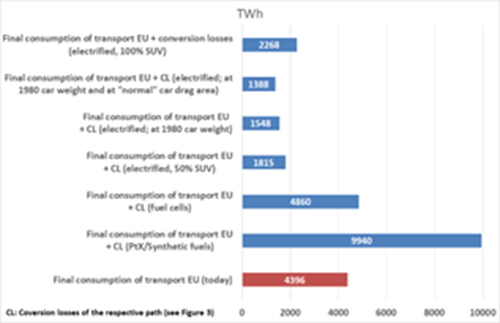
Source: own calculation
The role of energy efficiency and the EE1 Principle in climate policy – examples from recent climate assessment reports
Several important recent climate assessment reports underline the strong role that energy efficiency has to play in any climate strategy (Figure 6).
Figure 6: Examples from recent climate assessment reports emphasizing EE1
a) IPCC Working Group III
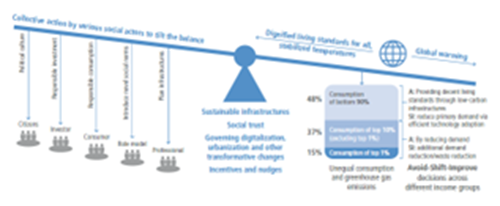
b) European Scientific Advisory Board on Climate Change
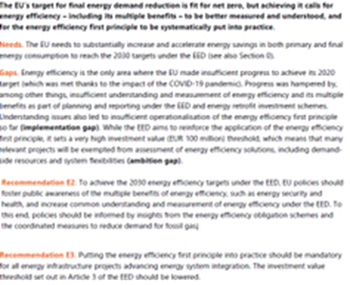
Source: European Scientific Advisory Board on Climate Change (CC): Assessment Report 2024. January 2024.
c) German Council of Experts on Climate Change

Source: Expertenrat für Klimafragen / Council of Experts on Climate Change (2022): Zweijahresgutachten 2022.
These include:
- IPCC Working Group III – Mitigation of Climate Change: Reducing energy demand via efficient technology adoption and decent living standards as a key mitigation strategy
- European Scientific Advisory Board on Climate Change: Energy Efficiency (incl. its multiple benefits) and the EE1 Principle play a key role towards EU climate neutrality
- Approach of the German Council of Experts on Climate Change: efficiency improvement, substitution, and activity reduction are considered at the same level
How to overcome the contradictions between the EE1 Principle and climate policy
Thus, the contradictions between the EE1 Principle and policies for climate neutrality have to be considered, as there are important arguments -based on the Multiple Impacts of climate neutrality pathways- supporting the EE1 principle in itself, such as security of supply (including supply of technologies and materials), competitiveness, and environmental impacts (including on biodiversity).
This requires the development of a hierarchical principle generalising the Energy Efficiency First Principle in climate policies. The environmental impacts of a number of climate policies (including renewables, the hydrogen economy, BECCS, and CCUS) -combined with low efficiencies from production to use- require its integration into the governance structures of the transformation of the energy system via a four-stage hierarchical approach:
- The "Energy-Efficiency-First" principle to minimize demand (including sufficiency options);
- Prioritising decarbonisation of the electricity sector, as this allows a move towards more efficient electric uses (e.g. heat pumps in building, electric processes in industry, electric cars, and trucks)1;
- Prioritising the use of alternatives based on renewable energy sources with similar services but with a lower environmental impact (e.g. direct electricity use, sustainable biomass/biofuels/biogas –the latter potentially combined with Carbon Capture, Storage and Use CCUS, taking into account their limited availability and sustainability criteria);
- Use of hydrogen and synthetic products or CCUS, once the first three stages, where appropriate, have been exhausted.
Following these four stages will help to select the most efficient supply pathway available, while minimizing the energy demand at each stage in accordance with the EE1 principle.
Key messages
The following key messages can be put forward from the previous sections:
- Introducing the Efficiency First (EE1) Principle into different transformations of the energy system (supply and demand) is an important task for this decade, but it is not enough.
- There are climate policies that both promote and contradict the EE1 Principle.
- Such climate policies may be necessary for hard-to-decarbonise sectors.
- However, this requires a broader frame of EE1 and the integration of a hierarchical principle generalising the Energy Efficiency First Principle into the governance of climate policies.
- Quantifying multiple benefits linked to climate neutrality pathways is an important tool to operationalise such a hierarchical principle in climate policies.
- Sufficiency-related energy savings will need to be a key policy target to take full advantage of this broader EE1 frame.
The webinar underlying this policy brief is available at https://www.youtube.com/watch?v=0bX7z5gWCOM
Notes
- 1: This step holds two sub-steps: (i) decarbonisation of electricity production and (ii) transformation of final energy demand towards electrification with efficient technologies.




